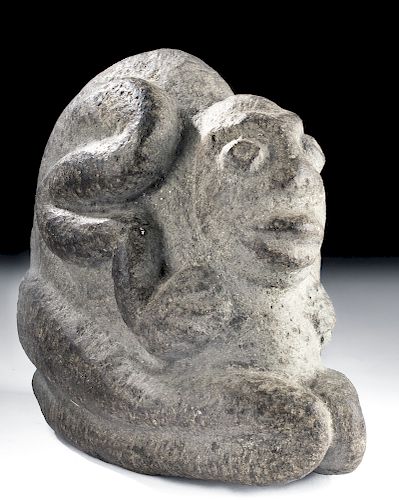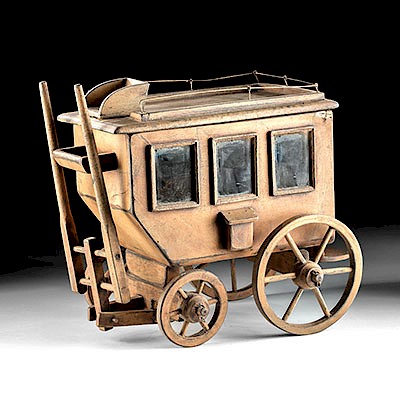Maya Basalt Seated Monkey - Batz / Howler Monkey God
Lot 26
About Seller
Artemis Fine Arts
686 S Taylor Ave, Ste 106
Louisville, CO 80027
United States
Selling antiquities, ancient and ethnographic art online since 1993, Artemis Gallery specializes in Classical Antiquities (Egyptian, Greek, Roman, Near Eastern), Asian, Pre-Columbian, African / Tribal / Oceanographic art. Our extensive inventory includes pottery, stone, metal, wood, glass and textil...Read more
Estimate:
$1,800 - $2,500
Absentee vs Live bid
Two ways to bid:
- Leave a max absentee bid and the platform will bid on your behalf up to your maximum bid during the live auction.
- Bid live during the auction and your bids will be submitted real-time to the auctioneer.
Bid Increments
| Price | Bid Increment |
|---|---|
| $0 | $25 |
| $300 | $50 |
| $1,000 | $100 |
| $2,000 | $250 |
| $5,000 | $500 |
| $10,000 | $1,000 |
| $20,000 | $2,500 |
| $50,000 | $5,000 |
| $100,000 | $10,000 |
| $200,000 | $20,000 |
About Auction
By Artemis Fine Arts
Nov 14, 2019
Set Reminder
2019-11-14 10:00:00
2019-11-14 10:00:00
America/New_York
Bidsquare
Bidsquare : Ethnographic | Tribal | American Frontier
https://www.bidsquare.com/auctions/artemis-gallery/ethnographic-tribal-american-frontier-4634
Featuring Pre-Columbian, Tribal / Oceanic, Spanish Colonial, historical examples from the Spanish, Mexican, and American frontiers, fossils, and more. All items offered for sale have been legally acquired, are legal to sell and are guaranteed to be as described or your money back. Artemis Fine Arts info@artemisgallery.com
Featuring Pre-Columbian, Tribal / Oceanic, Spanish Colonial, historical examples from the Spanish, Mexican, and American frontiers, fossils, and more. All items offered for sale have been legally acquired, are legal to sell and are guaranteed to be as described or your money back. Artemis Fine Arts info@artemisgallery.com
- Lot Description
Pre-Columbian, Guatemala, Postclassic Maya Period, ca. 1000 to 1200 CE. Carved from a beautiful piece of basalt in a very clever manner, a monkey who is full of personality, sitting/kneeling upon exceedingly long folded legs, arms curved at the sides with both hands placed upon his abdominal region - the digits of both hands and feet nicely delineated, and looking out with a silly grimace presenting bulging eyes, a wide nose, and smiling lips. An endearing simian, skillfully carved from a single stone - perhaps a depiction for Batz, the Maya Howler Monkey God, who was an important deity of the arts as well as a patron of scribes and sculptors. Size: 6.125" L x 3.125" W x 5.375" H (15.6 cm x 7.9 cm x 13.7 cm)
Monkeys were often depicted on Maya vases engaged in writing and carving human heads. Scholars have suggested that these activities may have represented a metaphor for creation of humankind. According to the Popol Vuh, Hun-Chowen and Hun-Batz 'One-Howler Monkey' were both artists and musicians who had a major conflict with their half-brothers, the Maya Hero Twins. It was this conflict that resulted in their transformation into monkeys.
Maya artisans used obsidian chisels, mallets and hammers made of flint and wood, and obsidian knives to create their sculptures. The use of basalt places this carving to the Maya uplands (lowlands carved in limestone); the three-dimensional carving in the round places it to the Postclassic period. The Spaniards wrote of the Aztecs believing that stone quarried to be carved had magical properties and was alive, able to speak and offer prophecies; [perhaps the Maya had similar beliefs.
Provenance: ex-private New Jersey, USA collection
All items legal to buy/sell under U.S. Statute covering cultural patrimony Code 2600, CHAPTER 14, and are guaranteed to be as described or your money back.
A Certificate of Authenticity will accompany all winning bids.
We ship worldwide and handle all shipping in-house for your convenience.
#149295Normal surface wear with old nicks/abrasions commensurate with age but intact. Nice deposits grace the surface.Condition
- Shipping Info
-
All shipping is handled in-house for your convenience. Your invoice from Artemis Gallery will include shipping calculation instructions. If in doubt, please inquire BEFORE bidding for estimated shipping costs for individual items.
-
- Buyer's Premium



 EUR
EUR CAD
CAD AUD
AUD GBP
GBP MXN
MXN HKD
HKD CNY
CNY MYR
MYR SEK
SEK SGD
SGD CHF
CHF THB
THB















